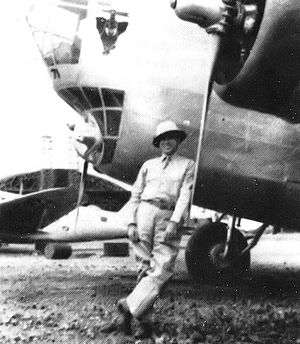35th Bombardment Squadron
| 35th Bombardment Squadron | |
|---|---|
|
35th Bomb Squadron Douglas B-18 Bolo with unofficial squadron emblem, Coolidge Field, Antigua, 1941 | |
| Active | 1940–1949 |
| Country | United States |
| Branch | United States Air Force |
| Role | Bombardment |
The 35th Bombardment Squadron a United States Air Force unit. Its last assignment was with the 322d Bombardment Group, based at Phillips Field, Beltsville, Maryland. It was inactivated on 27 June 1949.
History
Established as a heavy bombardment group at Langley Field, Virginia in early 1940 as part of the buildup of United States forces after the breakout of World War II in Europe.
Sixth Air Force
Was deployed to the Caribbean as part of the 1940 Destroyers for Bases Agreement with the British, departing Langley Field, on 26 October 1940, and was assigned to Coolidge Field, Antigua in the British West Indies (by way of Borinquen Field, Puerto Rico) before the subsequent dispersal of its original personnel and equipment. It had been assigned as a subordinate element of the 25th Bombardment Group. In May 1942, the unit was re designated as the 35th Bombardment Squadron (Medium).
On 31 October 1942, the first of the confusing reassignments that have tainted the overall picture of USAAF activities in the Caribbean was instituted. At that time, the squadron inherited the personnel and equipment of the 430th Bombardment Squadron (which had formerly been the 44th Reconnaissance Squadron). Additionally, the unit also got the personnel and equipment of the 99th Bombardment Squadron which had been based at Zandery Field, Surinam. Its personnel at Zandery becoming "A" and "B" Flight of the squadron, while the former 430th BS personnel and equipment became "C" and "D" Flights.
In January 1943, the Squadron Headquarters was moved from Coolidge Field back to Borinquen Field, Puerto Rico. "B" and "D" Flights of the 417th Bombardment Squadron (Medium) were reassigned to the squadron on 1 May 1943. In addition, for short periods in January, March, July and August 1943, while the German submarine warfare campaign was most critical, aircraft of the 80th Bombardment Squadron, 10th Bombardment Squadron, 8th Antisubmarine Squadron, 9th Antisubmarine Squadron and the Navy VB 130 were attached and/or operated intermingled with 35th BS aircraft. Additionally, during August 1943, aircraft and crews of the 23d Antisubmarine Squadron were attached to the 35th.
These reactions to the German threat were brought about, mainly between 19 and 30 July 1943, by new and very bold tactics being displayed by the Axis U-boats, now intent on fighting it out with patrolling aircraft on the surface. All of this makes it clear that the 35th BS was a prime element in the Allied anti-submarine campaign in the Caribbean. This realization was brought home on 1 August 1943 when operational and administrative control of the Squadron and its several detachments was transferred from the 25th Bombardment Group to Antilles Air Command.
By 31 December 1943 the Navy had taken over the antisubmarine mission and the far-flung detachments were inactivated. By this time, the unit was little more than an Operational Training Unit. Although the Squadron was reassigned to Waller Field, Trinidad, nominally, on 7 February 1944, as of 24 March this largely administrative transfer was ended and the Squadron was returned home to the United States. where the designation became that of a B-25 Mitchell Operational Training Unit at Alamagardo Army Airfield, New Mexico
The squadron was disbanded on 20 June 1944.
Cold War
Was activated as an Air Force Reserve squadron in July 1947 at Phillips Army Airfield, Maryland. May have operated some B-25s, although that is undetermined. Inactivated due to budget restraints in June 1949.
Lineage
- Constituted 35th Bombardment Squadron (Heavy) on 22 December 1939[1]
- Activated on 1 February 1940.
- Redesignated 35th Bombardment Squadron (Medium) on 7 May 1942
- Disbanded on 20 June 1944
- Reconstituted, and redesignated 35th Bombardment Squadron (Light), on 26 May 1947
- Activated in the reserve on 13 July 1947
- Inactivated on 27 June 1949.
Assignments
- 25th Bombardment Group, 1 February 1940 – 20 June 1944[2]
- Eleventh Air Force, 13 July 1947
- 322d Bombardment Group, 30 September 1947 – 27 June 1949.
Stations
- Langley Field, Virginia, February-26 October 1940
- Borinquen Field, Puerto Rico, 31 October 1941
- Coolidge Field, Antigua, 11 November 1941
- Zandery Field, Surinam, 1 November 1942
- Detachment operated from: Atkinson Field, British Guiana, 1 November 1942-c. 7 October 1943
- Detachment operated from: Port of Spain, Trinidad, 27 August-12 October 1943
- Vernam Field, Jamaica, c. 7 October 1943
- Waller Field, Trinidad, 7 February-24 March 1944
- Alamogordo AAF, New Mexico, April-20 June 1944
- Phillips Army Airfield, Maryland, 13 July 1947 – 27 June 1949
Aircraft
- Northrop A-17[1]
- B-18 Bolo, 1941–1943[1]
- B-25 Mitchell, 1943–1944[1]
References
![]() This article incorporates public domain material from the Air Force Historical Research Agency website http://www.afhra.af.mil/.
This article incorporates public domain material from the Air Force Historical Research Agency website http://www.afhra.af.mil/.
- 1 2 3 4 Conaway, William. "35th Bombardment Squadron (Medium)". VI Bomber Command In Defense Of The Panama Canal 1941–45.
- ↑ Conaway, William. "25th Bombardment Group (Medium))". VI Bomber Command In Defense Of The Panama Canal 1941–45.
- Maurer, Maurer, ed. (1982) [1969]. Combat Squadrons of the Air Force, World War II (PDF) (reprint ed.). Washington, DC: Office of Air Force History. ISBN 0-405-12194-6. LCCN 70605402. OCLC 72556.
- Hagdedorn, Dan (1995), Alae Supra Canalem: Wings Over the Canal, Turner Publishing, ISBN 1-56311-153-5
- Conaway, William. "VI Bomber Command In Defense Of The Panama Canal 1941–45". Planes and Pilots Of World War Two.

.jpg)